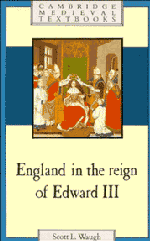Book contents
- Frontmatter
- Contents
- List of figures and tables
- Acknowledgements
- Map 1 Towns and villages mentioned in Chapters 3–6
- Map 2 Ecclesiastical sites mentioned in Chapter 9
- Part I Overview
- 1 Introduction
- 2 Survey of events 1307–1377
- Part II Economic challenges
- Part III Government and communities
- Part IV Politics
- Glossary
- Bibliography
- Index
2 - Survey of events 1307–1377
Published online by Cambridge University Press: 05 June 2012
- Frontmatter
- Contents
- List of figures and tables
- Acknowledgements
- Map 1 Towns and villages mentioned in Chapters 3–6
- Map 2 Ecclesiastical sites mentioned in Chapter 9
- Part I Overview
- 1 Introduction
- 2 Survey of events 1307–1377
- Part II Economic challenges
- Part III Government and communities
- Part IV Politics
- Glossary
- Bibliography
- Index
Summary
The highlights of Edward Ill's reign can be briefly narrated. Because his father's rule had been such a calamity, leaving a residue of mistrust that had to be cleared up before Edward could undertake any serious military campaigning, it is important to begin with Edward II's misfortunes.
He came to the throne on his father's death in July 1307. Though regal in appearance and welcomed at first, Edward displayed few of his father's statesmanlike qualities. By the end of the year, his favouritism toward Piers Gaveston and his abandonment of the war in Scotland caused grumbling among the barons. His coronation in February 1308 was carried out under a cloud and included an additional clause to the customary oath which stated that the king would uphold the laws chosen by his people.
Storms followed. Angered by Edward's lavish gifts to Gaveston, the barons secured Gaveston's exile in 1308, but by July 1309 Edward had succeeded in bringing him back, at the price of certain concessions. Edward and Gaveston did not change their ways so that in December 1310, under baronial pressure, Edward appointed a baronial committee to draw up reforms. When the Ordinances, as they were called, the most complete reform programme since the Provisions of Oxford in 1258, were finally issued in August 1311, they amounted to a comprehensive attack on Edward and his government. They called not only for the exile of Gaveston and other associates, but for stringent controls on royal appointments and policy making. Parliament was envisaged as the instrument of restraint.
- Type
- Chapter
- Information
- England in the Reign of Edward III , pp. 10 - 20Publisher: Cambridge University PressPrint publication year: 1991

